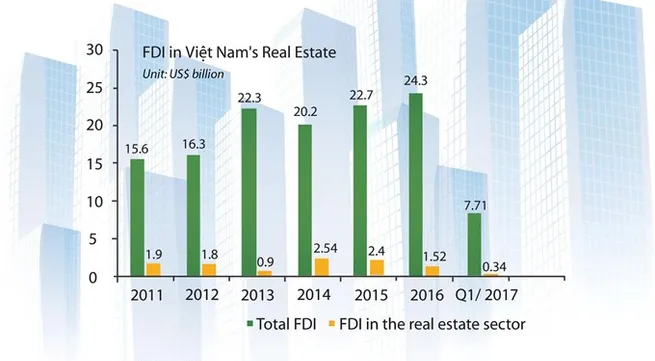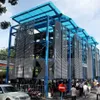Banks remain main backers of property market


|
| Foreign Direct Investment (FDI) flowing into the real estate market. — VNS infographic Thái Hà |
HCM CITY — The real estate market is recovering strongly and attracting huge sums of money from banks, foreign investors and overseas Vietnamese.
After a brief slowdown in the first quarter due to Tết (Lunar New Year) in January, the market has regained momentum since the beginning of the second quarter as the number of transactions started to pick up.
According to the Ministry of Construction’s housing and real estate market management department, 1,050 apartments were sold in Hà Nội in April, 5 per cent up from the previous month.
In HCM City, 1,170 were sold, a 7 per cent rise.
By late April the total value of inventories across the country was down by VNĐ624 billion to VNĐ28.37 trillion (US$1.25 billion).
They were down by VNĐ100 trillion or 77.93 per cent from the second quarter of 2013 and by VNĐ22.5 trillion or 44.25 per cent from the end of 2015.
In the first quarter of this year 924 new companies were established in the property sector, a 55 per cent rise year-on-year, according to a report from the Ministry of Planning and Investment.
The sector topped in terms of increase in the number of newly established companies.
Developers and other investors are pouring money into the sector. Banks remain the main players in the market in terms of investment despite several measures by the State Bank of Việt Nam to restrict loans to reduce risks.
Most notable among them is its Circular No 06/2016 that took effect last July, which reduced the maximum rate of short-term deposits that can be used for medium- and long-term loans from 60 per cent to 40 per cent.
It has also reduced the risk index to 200 per cent from the proposed 250 per cent with effect from this year.
According to the Việt Nam Real Estate Association (VNREA), credit institutions account for 70 per cent of the total capital flows into the property market.
Since the property sector has recovered and investors favour property over gold and stocks, the banks are offering credit at lower and lower rates to lure customers.
Việt Nam Public Joint Stock Commercial Bank (PVcomBank) has earmarked VNĐ10 trillion ($440 million) for lending to home developers and buyers.
An Bình Commercial Joint Stock Bank (ABBank) plans to lend VNĐ5 trillion for buying house or land and building or repairing houses.
In January Sài Gòn Thương Tín Commercial Bank (Sacombank) said it would earmark VNĐ3 trillion for mortgages at 8.5 per cent interest rate.
Asia Commercial Bank offers home loans at 7.5 per cent.
Nguyễn Hoàng Minh, deputy director of the State Bank of Việt Nam’s HCM City office, said at the end of the first quarter outstanding loans in the property sector in the city were worth VNĐ164.1 trillion ($7.22 billion), or 10.9 per cent of total loans and 19.3 per cent of long- and medium-term loans.
Loans to the property sector have increased by 4 per cent since the beginning of this year.
But Minh said the credit is carefully monitored and is lower than in 2007-08 when a property bubble formed and burst.
“This shows banks have been more cautious about giving loans to property projects and monitor credit growth better, which helps reduce the possibility of a real estate bubble like in the past.”
Managing property credit is crucial since the bursting of the bubble almost a decade ago has left a legacy of bad debts that plagues the sector even now, experts have said.
Dr Nguyễn Trí Hiếu, an economist, said a few years ago banks offered preferential loans for home buyers, leading to excessive money flows into the sector.
They should learn their lessons and be more cautious about property loans, he warned.
According to Hiếu, banks are now lending money to both the demand and supply sides of the market.
Lê Hoàng Châu, chairman of the HCM City Real Estate Association, said banks should control the flow of funds especially into the mid-priced and high-end property sectors, where most buyers are speculators and not people who buy houses for living.
Speculation would affect the stability of the market and increase inventories, making the bad debts situation worse, he added.
Since the beginning of this year the central bank has constantly urged banks to review and tighten lending to the property sector.
It reduced the cap on the use of short-term deposits for medium- and long-term loans to 50 per cent last January and to 40 per cent from next year to curb some of the fund flows into the property sector.
Besides, it has encouraged banks to lend to social housing projects to meet the demand of people who want to own a home.
Property 2nd in attracting FDI
Foreign Direct Investment (FDI) flowing into the real estate market is also on the rise.
The General Statistics Office reported that in the first quarter the sector attracted $340 million worth of FDI, or 4.5 per cent of the total amount, to rank second only behind manufacturing-processing.
Between 2011 and the first quarter of this year the real estate market has attracted more than $11 billion worth of FDI.
M&As by foreign investors, mostly from Japan, China, Singapore and South Korea, have continued strongly this year, according to Savills Việt Nam.
Besides, thanks to the amendment to the housing law allowing foreigners and overseas Vietnamese to buy houses in Việt Nam, foreigners are keen on the high-end apartment and resort segments.
In the second quarter the resort sector will continue to grow strongly and attract foreign and local investment, thanks to the country’s tourism potential, according to experts.
Sử Ngọc Khương, director of Savills Việt Nam, said there are two trends in the FDI: short-term investments in existing projects that expected to make returns of 8-10 per cent and long-term investment in housing development with expected profits of 20-30 per cent.
Housing developers depend less on banks when they tie up with foreign partners, he said.
Ben Gray, director of Capital Markets at Cushman & Wakefield Việt Nam, said Việt Nam would continue to attract more FDI this year as investors have more confidence in the market and see the country as an attractive destination.
Overseas remittances are another important source of investment for real estate projects.
In recent years remittances to the country have increased sharply, with a majority of the money going into the real estate market.
According to statistics from the National Financial Supervision Commission, the country received over $9 billion worth of overseas remittances in 2011, 52 per cent of which went into real estate.
Last year despite the economic difficulties, overseas remittances were still worth $9 billion, with 21 per cent going into property.
This dovetails with the central bank’s desire to reduce developers’ dependence on bank credit and for them to resort to other sources such as investment funds and foreign capital sources. — VNS

|
| Banks remain the main source of funds for the property sector, with both developers and home buyers depending overwhelmingly on them. — VNA/VNS Photo Trần Việt |
Tags:





